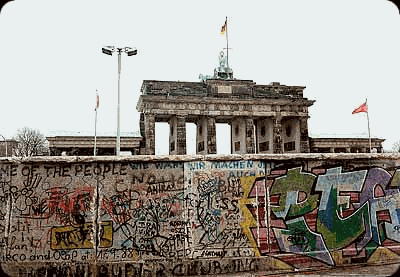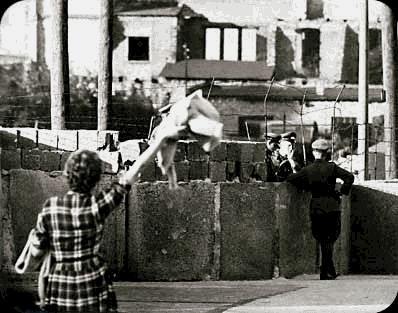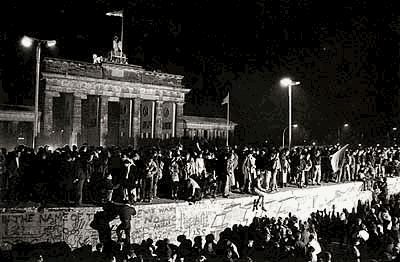|
The Berlin Wall: Barricades
Can Be Broken
|
Abstract

The Berlin Wall, erected November 13, 1961, served to separate communist
East Germany from Western influences. Intended to "protect" East Germans,
the wall actually was erected to prevent them from leaving the country.
The Wall finally came down August 13, 1989, reuniting families and symbolizing
the end of the cold war was near.
Historical
Background
The initial plans for Allied occupation of Germany were prepared in
1944 in London by the European Advisory Commission. In this agreement,
Germany would be divided into four occupational zones governed by Great
Britain, the United States, France, and the Soviet Union. The city of Berlin,
which would be in the Soviet occupational zone, would be divided among
the four powers as well. They would govern Berlin collectively in the Kommandatura.
This plan was not very successful and led to the following events. November
30, 1948 Communists set up a separate city council in the Soviet sector.
June 1948 Great Britain, France, and the United States resolved to let
the Western German people, the people under their zones of occupation establish
their own government based on a democratic provisional constitution. May
23, 1949 the Federal Republic of Germany (West Germany) was proclaimed.
The Berlin blockade (June 24, 1948-May 12, 1949), during which the Soviet’s
blockaded all connections between West Berlin and the Western powers, led
further to the demise of the Four Power cooperation. .
By the time of the blockade, there was a major contrast between the
East and West Berlin. West Berlin was a thriving democratic, capitalist
city, while East Berlin was in drab poverty. Trying to escape the forced
collectivization of goods and agriculture, numerous shortages, and a police
state, many fled to West Berlin. To maintain the stability of the communist
regime, the East German leaders felt that these floods of people had to
be stopped.
Research
Report
The first "sealing of the border" began in May 1952. After initially
separating the East/ West Germany Border, East German authorities turned
to the city of Berlin. They barricaded 200 streets linking the two, and
set up 81 police controls at the access points that remained open. All
but twenty telephone lines connecting the sections were cut; Tram and bus
traffic between the two was cancelled. A punishment of 16 months to four
years of imprisonment was given for the offense of "fleeing the Republic".
Despite all this, Berlin remained the only way possible to escape to the
West and free people from oppression. Nearly 50,000 crossed each day; a
total of 1,600,000 crossed between 1949 and 1961 (when the Berlin Wall
was finally erected).
The "Berlin Crisis" began November 26, 1958, when Nikita Khrushchev,
Premier of Soviet Ministers, issued an ultimatum to the Western Powers.
He declared that they had six months to turn West Berlin into a "demilitarized
free city". If they failed to do so, he would sign a separate peace treaty
with East Germany. A series of unsuccessful conferences were held: Geneva
(May-Aug 1959), Paris (May 1960), and Vienna (June 1961), all with no results.
Meanwhile hundreds of thousands of East Germans escaped to the West.
 Ulbricht,
leader of East Germany and founder of the German Communist Party, decided
that the survival of the communist East Germany regime depended on the
complete closing of East/ West Berlin. He met with Khrushchev in Moscow
August 5, 1961 at the meeting of the Communist Party heads to ask for support.
Two days later, Khrushchev announced on radio that the "handy escape route"
had to be closed. Upon hearing this, thousands left everything they possessed
and crossed the border before it was too late.
Ulbricht,
leader of East Germany and founder of the German Communist Party, decided
that the survival of the communist East Germany regime depended on the
complete closing of East/ West Berlin. He met with Khrushchev in Moscow
August 5, 1961 at the meeting of the Communist Party heads to ask for support.
Two days later, Khrushchev announced on radio that the "handy escape route"
had to be closed. Upon hearing this, thousands left everything they possessed
and crossed the border before it was too late.
Operation "Wall of China" began August 12, 1961 when Ulbricht sent orders
to Honecker to make preparations for closing the border. August 13, 1961
at 1:11 a.m., as people slept on that Sunday and national holiday, soldiers
began placing barbed wire between the two sections of the city. Within
a few hours the S-Bahn and any remaining traffic between the two was closed;
by August 23rd relatives could not pass through without a permanent
resident card. Eastern Berlin was isolated.
The Western powers, content that the USSR had not signed a separate
treaty with East Germany, offered no formal protest. After it was apparent
that there would be no protest, barriers began replacing the barbed wire
(August 15). This two-day gap allowed 6, 904 East Germans to escape.
Over time the wall became more and more impassible. After four "generations"
of wall, it achieved its final appearance in 1979-80. Covering 103 mi overall
(26.8 mi in Berlin) and consisting of concrete slabs 11.5’-14’ high (in
some places an additional 10’-13’ of wire mesh would be added on top of
the concrete) and 6" wide with 116 watch towers (32 along the East/West
Berlin border) the Berlin Wall was not an easy obstacle to overcome. Armed
guards were trained to shoot anyone who attempted to escape. (The following
link: www.wall-berlin.org/gb/mur_tex3.htm
shows what an escapee would have to encounter.)
Despite all these obstacles many people successfully escaped. Their
methods varied considerably. 5,043 successfully scaled the wall. Others
doctored cars and hid in the bottom. Jumping off buildings was another
extreme measure taken. The grandest escape occurred October 3-5, 1964,
where 57 East Germans escaped through a tunnel dug for them by separated
family members and students in West Berlin. The tunnel was 50’ deep, 475’
long, and 2’3" high.
After increased tension and riots in December 1963, an agreement was
made allowing West Berliners to visit friends and family over Christmas
and New Year. Other visitation provisions were made, allowing for East
Germans to visit the West for special occasions. After June 1968 travelers
between West Germany and West Berlin were required to buy and carry a passport
and visa. September 3, 1971 the four occupying powers signed an agreement
in which the USSR guaranteed access to West Berlin and the West acknowledged
that West Berlin was not an integral part of West Germany. West Berliners
could now stay in East Berlin for 30 days each year.

The Wall remained erect from 1961-1989. On May 2,1989, after Mikal Gorbachev
declared that Moscow was no longer willing to use force to prevent democratic
transformation of its satellite states, Hungary took down its iron curtain.
East Germans poured out; 220,000 had passed to the West over six months.
On October 7, 1989 East Germany’s 40th anniversary celebration
turned into riotous protests against the current communist regime. The
people called for Gorbachev’s, a guest at the ceremony, help. He responded
"whoever comes too late is punished by life". This warning encouraged SED
leaders to get rid of Honecker. November 4th a demonstration
of a million people on the Alexanderplatz called for basic freedoms from
the SED. This led to the resignations of party leaders November 8th..
Trying to save East Germany, they ceded to the demonstrators' main demands:
to move around freely. November 9th it was announced that East
Germans could finally move freely into West Germany. Thousands passed through
and celebrated that night; families were reunited. The Wall would separate
them no longer.
Historical
Significance
The Wall served as the epitome of the Cold War, a visual representation
of the division of Europe. By contrasting West and East Berlin one can
clearly see the differences between communism and democracy. The collapse
of the Berlin Wall foretold the final collapse of communism, which would
occur two years later with the division of the Soviet Union.
References
Heller, Deanne and David. The Berlin Wall. New York: Walker and
Company, 1962.
Slusser, Robert M. The Berlin Crisis of 1961. Baltimore: The
Johns Hopskins University Press, 1973.
Speier, Hans. Divided Berlin. New York: Fredrick A. Praeger,
1961.
Tusa, Ann. The Last Division, Berlin and the Wall. London: Hodder
and Staighton, 1996.
Wyden, Peter. Wall: The Inside Story of Divided Berlin. New
York: Simon and Schuster, 1989.
Web Resources
www.dailysoft.com/berlinwall
A very good timeline.
www.newseum.org/berlinwall
Good pictures.
http://userpage.chemie.fu-berlin.de/BIW/wall.html
Good summary. Lots of links!
www.wall-berlin.org
Very complete site: lots of information and pictures!
www.webster.monroe.edu/spry/berlinwall.html
Pretty good site. Links and questions to ask yourself provided.
 Ulbricht,
leader of East Germany and founder of the German Communist Party, decided
that the survival of the communist East Germany regime depended on the
complete closing of East/ West Berlin. He met with Khrushchev in Moscow
August 5, 1961 at the meeting of the Communist Party heads to ask for support.
Two days later, Khrushchev announced on radio that the "handy escape route"
had to be closed. Upon hearing this, thousands left everything they possessed
and crossed the border before it was too late.
Ulbricht,
leader of East Germany and founder of the German Communist Party, decided
that the survival of the communist East Germany regime depended on the
complete closing of East/ West Berlin. He met with Khrushchev in Moscow
August 5, 1961 at the meeting of the Communist Party heads to ask for support.
Two days later, Khrushchev announced on radio that the "handy escape route"
had to be closed. Upon hearing this, thousands left everything they possessed
and crossed the border before it was too late.

